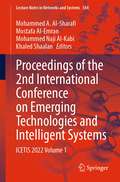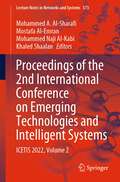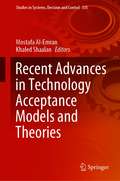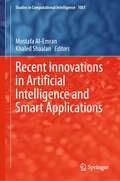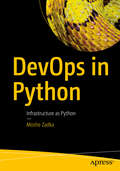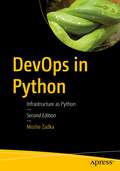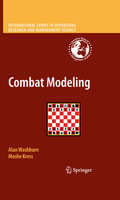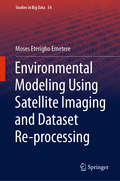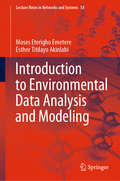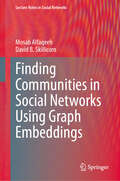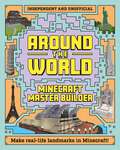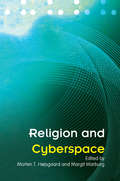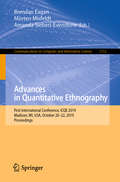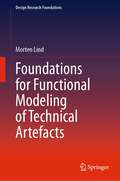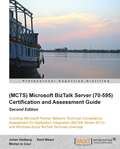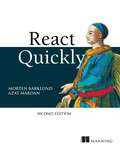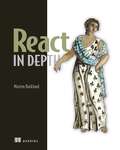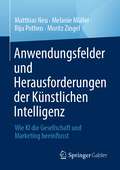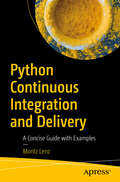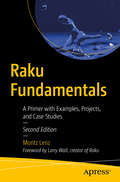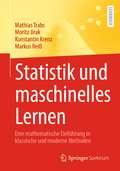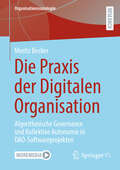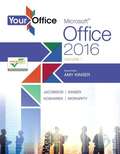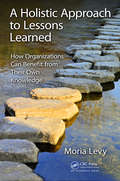- Table View
- List View
Proceedings of the 2nd International Conference on Emerging Technologies and Intelligent Systems: ICETIS 2022 Volume 1 (Lecture Notes in Networks and Systems #584)
by Khaled Shaalan Mostafa Al-Emran Mohammed A. Al-Sharafi Mohammed Naji Al-KabiThis book sheds light on the recent research directions in intelligent systems and their applications. It involves two main themes, including management information systems and advances in information security and networking. The discussion of the most recent designs, advancements, and modifications of intelligent systems, as well as their applications, is a key component of the chapters contributed to the aforementioned subjects.
Proceedings of the 2nd International Conference on Emerging Technologies and Intelligent Systems: ICETIS 2022, Volume 2 (Lecture Notes in Networks and Systems #573)
by Khaled Shaalan Mostafa Al-Emran Mohammed A. Al-Sharafi Mohammed Naji Al-KabiThis book sheds light on the recent research directions in intelligent systems and their applications. It involves four main themes: artificial intelligence and data science, recent trends in software engineering, emerging technologies in education, and intelligent health informatics. The discussion of the most recent designs, advancements, and modifications of intelligent systems, as well as their applications, is a key component of the chapters contributed to the aforementioned subjects.
Recent Advances in Technology Acceptance Models and Theories (Studies in Systems, Decision and Control #335)
by Khaled Shaalan Mostafa Al-EmranThis book tackles the latest research trends in technology acceptance models and theories. It presents high-quality empirical and review studies focusing on the main theoretical models and their applications across various technologies and contexts. It also provides insights into the theoretical and practical aspects of different technological innovations that assist decision-makers in formulating the required policies and procedures for adopting a specific technology.
Recent Innovations in Artificial Intelligence and Smart Applications (Studies in Computational Intelligence #1061)
by Khaled Shaalan Mostafa Al-EmranThis book tackles the recent research trends on the role of AI in advancing automotive manufacturing, augmented reality, sustainable development in smart cities, telemedicine, and robotics. It sheds light on the recent AI innovations in classical machine learning, deep learning, Internet of Things (IoT), Blockchain, knowledge representation, knowledge management, big data, and natural language processing (NLP). The edited book covers empirical and reviews studies that primarily concentrate on the aforementioned issues, which would assist scholars in pursuing future research in the domain and identifying the possible future developments of AI applications.
DevOps in Python: Infrastructure as Python
by Moshe ZadkaExplore and apply best practices for efficient application deployment. This book draws upon author Moshe Zadka's years of Dev Ops experience and focuses on the parts of Python, and the Python ecosystem, that are relevant for DevOps engineers. You'll start by writing command-line scripts and automating simple DevOps-style tasks. You'll then move on to more advanced cases, like using Jupyter as an auditable remote-control panel, and writing Ansible and Salt extensions. This work also covers how to use the AWS API to manage cloud infrastructure, and how to manage Python programs and environments on remote machines.Python was invented as a systems management language for distributed operating systems, which makes it an ideal tool for DevOps. Assuming a basic understanding of Python concepts, this book is perfect for engineers who want to move from operations/system administration into coding. What You'll LearnUse third party packages and create new packagesCreate operating system management and automation code in PythonWrite testable code, and testing best practicesWork with REST APIs for web clientsWho This Book Is ForJunior or intermediate sysadmin who has picked up some bash and Python basics.
DevOps in Python: Infrastructure as Python
by Moshe ZadkaTake advantage of Python to automate complex systems with readable code. This new edition will help you move from operations/system administration into easy-to-learn coding.You'll start by writing command-line scripts and automating simple DevOps-style tasks followed by creating reliable and fast unit tests designed to avoid incidents caused by buggy automation. You’ll then move on to more advanced cases, like using Jupyter as an auditable remote-control panel and writing Ansible and Salt extensions.The updated information in this book covers best practices for deploying and updating Python applications. This includes Docker, modern Python packaging, and internal Python package repositories. You'll also see how to use the AWS API, and the Kubernetes API, and how to automate Docker container image building and running. Finally, you'll work with Terraform from Python to allow more flexible templating and customization of environments.What You'll LearnUnderstand operating system automation with PythonPackage Python applicationsUse Python as a DevOps consoleReview Cloud automation with PythonWho This Book Is ForDevOps engineer. Site Reliability Engineer, or similar (including Platform, Production, and Systems), and whose organization uses Python.
Combat Modeling (International Series in Operations Research & Management Science #134)
by Alan Washburn Moshe Kress"Combat Modeling" is a systematic learning resource and reference text for the quantitative analysis of combat. After a brief overview, authors Washburn and Kress present individual chapters on shooting without feedback; shooting with feedback; target defense; attrition models; game theory and wargames; search; unmanned aerial vehicles; and terror and insurgency. Three appendices provide a review of basic probability concepts, probability distributions, and Markov models; an introduction to optimization models; and a discussion of Monte-Carlo simulations. Drawing on their many years of experience at the Naval Postgraduate School in Monterey, California, Washburn and Kress have created a reference that will provide the tools and techniques for analysts involved in the underpinnings of combat decisions. This is a book that can be used as a military manual, reference book, and textbook for military courses on this vital subject.
Environmental Modeling Using Satellite Imaging and Dataset Re-processing (Studies in Big Data #54)
by Moses Eterigho EmetereThis book introduces methods of re-processing images to extract numerical information that can be used to quantify the observables in environmental modelling. Experiments or procedures that yield large images can be statistically or parametrically examined. Through the use of open source libraries, the book shows how ‘big data’ in the form of images or datasets can be comparatively analysed along same defined procedures or standards. This book helps to solve the challenges of discarding datasets that are relevant directly or indirectly to the research. The habit of screening datasets leads to the discard of over 90% of the original dataset or images generated in the experiments or procedure. If the images or datasets are generated under the same principles or conditions, then each measurement may be the narrative of unique events. The focus of this book is to enlighten researchers on how to analyse measurements with the aim of ensuring 100% utilization.
Introduction to Environmental Data Analysis and Modeling (Lecture Notes in Networks and Systems #58)
by Esther Titilayo Akinlabi Moses Eterigho EmetereThis book introduces numerical methods for processing datasets which may be of any form, illustrating adequately computational resolution of environmental alongside the use of open source libraries. This book solves the challenges of misrepresentation of datasets that are relevant directly or indirectly to the research. It illustrates new ways of screening datasets or images for maximum utilization. The adoption of various numerical methods in dataset treatment would certainly create a new scientific approach. The book enlightens researchers on how to analyse measurements to ensure 100% utilization. It introduces new ways of data treatment that are based on a sound mathematical and computational approach.
Finding Communities in Social Networks Using Graph Embeddings (Lecture Notes in Social Networks)
by David B. Skillicorn Mosab AlfaqeehCommunity detection in social networks is an important but challenging problem. This book develops a new technique for finding communities that uses both structural similarity and attribute similarity simultaneously, weighting them in a principled way. The results outperform existing techniques across a wide range of measures, and so advance the state of the art in community detection. Many existing community detection techniques base similarity on either the structural connections among social-network users, or on the overlap among the attributes of each user. Either way loses useful information. There have been some attempts to use both structure and attribute similarity but success has been limited. We first build a large real-world dataset by crawling Instagram, producing a large set of user profiles. We then compute the similarity between pairs of users based on four qualitatively different profile properties: similarity of language used in posts, similarity of hashtags used (which requires extraction of content from them), similarity of images displayed (which requires extraction of what each image is 'about'), and the explicit connections when one user follows another. These single modality similarities are converted into graphs. These graphs have a common node set (the users) but different sets a weighted edges. These graphs are then connected into a single larger graph by connecting the multiple nodes representing the same user by a clique, with edge weights derived from a lazy random walk view of the single graphs. This larger graph can then be embedded in a geometry using spectral techniques. In the embedding, distance corresponds to dissimilarity so geometric clustering techniques can be used to find communities. The resulting communities are evaluated using the entire range of current techniques, outperforming all of them. Topic modelling is also applied to clusters to show that they genuinely represent users with similar interests. This can form the basis for applications such as online marketing, or key influence selection.
Minecraft Builder - Around the World: Independent and Unofficial
by Mortimer Children's BooksTravel the world in Minecraft! This easy-to-follow guide is filled with detailed instructions on how to make your own versions of the world's greatest landmarks. It includes straightforward instructions on how to build 13 different structures from around the world, including the Statue of Liberty, the Easter Island Heads, Sydney Opera House, Burj Khalifa, the Eiffel Tower, and many more.Builds range in difficulty, so there's something for every reader to try. Plus, every section is filled with cool info about the world's greatest wonders, meaning this is the perfect title for young learners. It's a fantastic way to combine geography, history and creativity into an amazing, fulfilling Minecraft experience.
Religion and Cyberspace
by Margit Warburg Morten T. HøjsgaardIn the twenty-first century, religious life is increasingly moving from churches, mosques and temples onto the Internet. Today, anyone can go online and seek a new form of religious expression without ever encountering a physical place of worship, or an ordained teacher or priest. The digital age offers virtual worship, cyber-prayers and talk-boards for all of the major world faiths, as well as for pagan organisations and new religious movements. It also abounds with misinformation, religious bigotry and information terrorism. Scholars of religion need to understand the emerging forum that the web offers to religion, and the kinds of religious and social interaction that it enables.Religion and Cyberspace explores how religious individuals and groups are responding to the opportunities and challenges that cyberspace brings. It asks how religious experience is generated and enacted online, and how faith is shaped by factors such as limitless choice, lack of religious authority, and the conflict between recognised and non-recognised forms of worship. Combining case studies with the latest theory, its twelve chapters examine topics including the history of online worship, virtuality versus reality in cyberspace, religious conflict in digital contexts, and the construction of religious identity online. Focusing on key themes in this groundbreaking area, it is an ideal introduction to the fascinating questions that religion on the Internet presents.
Advances in Quantitative Ethnography: First International Conference, ICQE 2019, Madison, WI, USA, October 20–22, 2019, Proceedings (Communications in Computer and Information Science #1112)
by Brendan Eagan Morten Misfeldt Amanda Siebert-EvenstoneThis book constitutes the refereed proceedings of the First International Conference on Quantitative Ethnography, ICQE 2019, held in Madison, Wisconsin, USA, in October 2019. It consists of 23 full and 9 short carefully reviewed papers selected from 52 submissions. The contributions come from a diverse range of fields and perspectives, including learning analytics, history, and systems engineering, all attempting to understand the breadth of human behavior using quantitative ethnographic approaches.
Foundations for Functional Modeling of Technical Artefacts (Design Research Foundations)
by Morten LindThis monograph provides a new framework for modelling goals and functions of control systems. It demonstrates how to use means-end concepts and various aspects of action to describe the relations between the structure, dispositions, functions, and goals of technical systems and with human action. The author developed this approach as part of his research on Multilevel Flow Modelling (MFM). He based the framework on concepts of action and means-end analysis drawing on existing theories from several areas of study, including philosophical logic, semiotics, and phenomenological approaches to social science. Here, he applies it to three modeling situations related to the interaction of technical artefacts and humans. One involves the relation between designer and artefact, another the relation between technical artefact and its user, and the third the relation between a natural object and its user. All three are relevant for modelling complex automated processes interacting with human operators. The book also discusses challenges when applying the foundations for modelling of technical artefacts. Overall, it provides a cross disciplinary integration of several fields of knowledge. These disciplines include intelligent process control, human machine interaction, and process and automation design. As a result, researchers and graduate students in computer science, engineering, and philosophy of technology will find it a valuable resource.
(MCTS) Microsoft BizTalk Server (70-595) Certification and Assessment Guide: Second Edition
by Johan Hedberg Kent Weare Morten La CourA hands-on certification guide with practical examples and sample questions and answers to help BizTalk developers pass the Microsoft BizTalk Server 2010 (70-595) exam. If you are an intermediate level BizTalk developer who wants to pass the Microsoft BizTalk Server 2010 (70-595) exam, then this book is for you. A working knowledge of fundamental BizTalk concepts around the core messaging engine and building business processes using orchestrations is assumed but not required. In addition, core knowledge of Windows Communication Foundation (WCF) and a basic understanding of Electronic Data Interchange (EDI) is recommended.
React Quickly, Second Edition
by Azat Mardan Morten BarklundLearn the skills you need to build React applications quickly! This fully revised second edition introduces JSX, functional components, React hooks, event and form handling, and more.In React Quickly, Second Edition you will learn how to: Master React fundamentals Implement best practices and the components of good architecture Build intuitive user interfaces Create dynamic components with JSX Use lightweight functional components in React Make your app interactive with stateful components Utilize React hooks Handle events like button clicks and pass data between components Build your skills with React fast! There&’s no slow theory and tedious history in React Quickly—you&’ll dive into React code right from the very first chapter. As you go, you&’ll explore over 80 useful and practical examples that put React into action. This new second edition has been completely rewritten to cover the latest developments in the React framework. Perfect, whether you&’re a React beginner or an experienced pro looking to keep their skills up to date. About the technology React makes it a breeze to build beautiful, reliable web frontends. This amazing JavaScript library has a modular architecture, so you can create, combine, and test components seamlessly. React is perfect for small prototypes, enterprise scale sites, and everything in between. About the book React Quickly, Second Edition offers a unique approach to learning the React framework. More than 80 concise examples guide you from your first steps through advanced applications. You&’ll appreciate the up-to-date coverage of functional components, React hooks, and web accessibility, along with interesting projects to practice your new skill. What's inside Master React fundamentals Best practices of component-based design Create dynamic components with JSX Make your app interactive with stateful components About the reader For developers comfortable building web applications with JavaScript. About the author Morten Barklund is an expert in React, web testing, and accessibility and is the founder of Coding Heaven. Azat Mardan is a seasoned software engineer, startup mentor, and best-selling author. Table of Contents 1 Meeting React 2 Baby steps with React 3 Introduction to JSX 4 Functional Components 5 Making React interactive with states 6 Effects and the React component life cycle 7 Hooks to fuel your web applications 8 Handling events in React 9 Working with forms in React 10 Advanced React hooks for scaling 11 Project: Website menu 12 Project: Timer 13 Project: Task manager
React in Depth
by Morten BarklundA guide to the advanced React skills used by the very best React developers.React in Depth teaches the React libraries, tools and techniques that are vital to build amazing apps. You&’ll put each skill you learn into practice with hands-on projects like a goal-focused task manager, expenses tracker, and custom UI library. In React in Depth you will learn how to: • Assess technologies in the React ecosystem • Implement advanced component patterns to improve React code • Optimize React performance for a smooth user experience • Use developer tooling for better code maintenance and debugging • Work with TypeScript for type safety • Use CSS in JavaScript for efficient styling • Manage data in React, including remote data and reactive caching • Unit test React components for quality assurance and bug prevention • Use popular React frameworks for building production-ready applications React in Depth focuses on the modern best practices of React development, with full and up-to-date coverage of the latest features and changes to the React ecosystem. This book highlights the advanced techniques that turn a React pro into a React wizard, and how you can future-proof your career by mastering new React technologies as they emerge. About the technology What does knowing React in depth mean? It means writing clean, modular code that you can test and refactor. It means applying design patterns and architectural principles to real-world problems. It means collaborating effectively with other developers and harnessing the power of React&’s rich ecosystem. That&’s exactly what this book delivers! About the book React in Depth teaches you the best practices of React development, with up-to-date coverage of the React ecosystem. In it, you&’ll learn how to put NextJS, Remix, TypeScript, and more in your React toolbox. You&’ll explore advanced topics like component patterns, optimization techniques, and developer tooling. Along the way, you&’ll collect pro tips for creating applications that can scale without sacrificing performance or stability. Each skill is proven with hands-on examples, from a weather app to a Wordle clone. What's inside • Optimize React performance • Use CSS in JavaScript • Manage data in React • Unit test React components About the reader For web developers familiar with the basics of React. About the author Morten Barklund works as a staff fullstack engineer at Corti, a leading AI healthtech startup. Table of Contents 1 Developer&’s guide to the React Ecosystem 2 Advanced component patterns 3 Optimizing React performance 4 Better code maintenance with developer tooling 5 TypeScript: Next-level JavaScript 6 Mastering TypeScript with React 7 CSS in JavaScript 8 Data management in React 9 Remote data and reactive caching 10 Unit-testing React 11 React website frameworks 12 Project: Build an expense tracker with Remix 13 Project: Create a React UI library 14 Project: Develop a word game in React
Sustainable Squirrel Conservation: A Modern Reassessment of Family Sciuridae
by Falk Huettmann Moriz SteinerThis book attempts to move the family of squirrels (Sciuridae) out of the shadow of large charismatic mammals and to highlight management failures with the goal of moving towards an improved conservation approach. Particular attention is paid to the influence of taxonomic science on squirrel conservation. In addition, the authors show how human-driven climate change, global change and modern politics are shaping global squirrel populations as well as their surrounding environments and ecosystems.Squirrels are widespread around the globe, naturally occurring on every continent except Antarctica and Oceania, and they are certainly among the animals most commonly encountered in everyday life. Despite this, the authors of this volume identify worrying gaps in squirrel conservation. Squirrels are often hunted, trapped, poached, and stressed, and management strategies and legislation are often devised in the absence of proper knowledge of issues such as population sizes, taxonomies, and trends. Together, this can result in severe population declines and even species extinction. By assessing their taxonomic situation, ecology, the evolution and divergence of Sciuridae around the globe, and squirrels’ well-being across habitats, the authors set a baseline from which to launch future investigations into the conservation of squirrels and other species. Additionally, the authors highlight the influences of climate change, unsustainable growth, and various man-made threats to the future of this family.
Anwendungsfelder und Herausforderungen der Künstlichen Intelligenz: Wie KI die Gesellschaft und Marketing beeinflusst
by Matthias Neu Melanie Müller Biju Pothen Moritz ZingelDieses Buch gibt einen Überblick über die historische Entwicklung der Künstlichen Intelligenz und definiert die wichtigsten Begriffe. Dabei werden aktuelle Anwendungsfelder der KI ausführlich dargestellt und Chancen, Risiken und Herausforderungen dieser Entwicklung beleuchtet. Abschließend gehen die Autoren auf Fragen der digitalen Ethik ein.
Python Continuous Integration and Delivery: A Concise Guide with Examples
by Moritz LenzGain the techniques and tools that enable a smooth and efficient software development process in this quick and practical guide on Python continuous integration (CI) and continuous delivery (CD). Based on example applications, this book introduces various kinds of testing and shows you how to set up automated systems that run these tests, and install applications in different environments in controlled ways. Python Continuous Integration and Delivery tackles the technical problems related to software development that are typically glossed over in pure programming texts.After reading this book, you’ll see that in today's fast-moving world, no software project can afford to go through development, then an integration phase of unpredictable length and complexity, and finally be shipped to the customer -- just to find out that the resulting application didn't quite fill their need. Instead, you’ll discover that practicing continuous integration and continuous delivery reduces the risks by keeping changes small and automating otherwise painful processes. What You Will LearnCarry out various kinds of testing, including unit testing and continuous integration testing, of your Python code using JenkinsBuild packages and manage repositoriesIncorporate Ansible and Go for automated packaging and other deploymentsManage more complex and robust deploymentsWho This Book Is ForPython programmers and operating staff that work with Python applications.
Raku Fundamentals: A Primer with Examples, Projects, and Case Studies
by Moritz LenzGain the skills to begin developing Raku applications from the ground up in this hands-on compact book, which includes a foreword from Larry Wall, creator of Perl. You’ll learn enough to get started building with Raku, using Raku's gradual typing, handy object orientated features, powerful parsing capabilities, and human-usable concurrency. This book has been updated to include the latest version of Raku based upon the Perl 6.d major version which includes over 3,400 new commits in its specification. After a short introduction, each chapter develops a small example project, explaining the Raku features used. When the example is done, you’ll explore another aspect, such as optimizing further for readability or testing the code. Along the way you’ll see Raku basics, such as variables and scoping; subroutines; classes and objects; regexes; and code testing. When you’ve mastered the basics, Raku Fundamentals moves onto more advanced topics to give you a deeper understanding of the language. You’ll learn, amongst other things, how to work with persistent storage, how to generate good error messages, and how to write tricky applications such as a file and directory usage graph and a Unicode search tool. What You Will Learn Get coding with latest version of Raku Work on several hands-on examples and projects Integrate Python libraries into your Raku-based programs Parse INI files using regexes and grammars Build a date-time converter Carry out refactoring and other automated tests Who This Book Is For If you already know one or more programming languages, and want to learn about Raku, then this book is for you.
Statistik und maschinelles Lernen: Eine mathematische Einführung in klassische und moderne Methoden
by Markus Reiß Mathias Trabs Moritz Jirak Konstantin KrenzDieses Lehrbuch liefert einen Einstieg in die mathematische Statistik und baut systematisch eine Brücke zum maschinellen Lernen. Dabei werden sowohl klassische und bis heute wichtige Verfahren untersucht als auch moderne Klassifikationsmethoden des statistischen Lernens. Diese werden mathematisch präzise analysiert und anhand von lebensnahen Beispielen illustriert. Das Buch verschafft den Leserinnen und Lesern einen Überblick über statistische Methoden der Datenanalyse und deren mathematischen Grundprinzipien. Der Fokus auf nicht-asymptotische Resultate erlaubt den Zugang zu modernen Anwendungen und führt an aktuelle Forschungsfragen heran. Aufgaben am Kapitelende runden das Buch ab.
Die Praxis der Digitalen Organisation: Algorithmische Governance und Kollektive Autonomie in DAO-Softwareprojekten (Organisationssoziologie)
by Moritz BeckerDezentrale Autonome Organisationen (DAOs) sind ein neues Organisationsmodell, das auf der algorithmischen Festschreibung von Regeln in einem blockchainbasierten Softwareprogramm basiert. Ihr Versprechen: Eine alternative Art und Weise des Organisierens zu ermöglichen, die sich durch nichthierarchische („dezentrale“) Zusammenarbeit und umfassende technologische Koordination auszeichnet. Als Musterbeispiel der „Governance durch Algorithmen“ verdeutlichen DAOs, dass in der digitalisierten Gesellschaft immer häufiger Konstellationen auftreten, in denen algorithmische und menschliche Handlungsmacht aufeinandertreffen. In dem vorliegenden Buch wird vor diesem Hintergrund untersucht, wie algorithmische Governance der eingesetzten Softwareprogramme und die Autonomie menschlicher Handelnder in der Organisationspraxis von DAOs zusammenwirken. Zur Beantwortung dieser Frage werden empirische Fallstudien in drei DAO-Softwareprojekten durchgeführt. Die Auswertung ergibt, dass beide ein Spannungsverhältnis konstituieren: So stehen die Mitglieder der Projekte in zahlreichen Situationen des Projektalltags vor der Herausforderung, die algorithmisch festgelegten Regeln und Ressourcen mit menschlichen Strukturierungsleistungen zu vereinen.
Your Office: Microsoft® Office 2016
by Amy Kinser Jacobson Kinser Kosharek MoriarityThe Your Office series prepares students to use both technical and soft skills in the real world. Hands-on technical content is woven into realistic business scenarios and focuses on using Microsoft Office® as a decision-making tool. The series features a unique running business scenario that connects all of the cases together and exposes students to using Office to solve problems relating to business areas like finance and accounting, production and operations, sales and marketing. p><p> Each chapter introduces a realistic business case for students to complete via hands-on steps that are easily identified in blue shaded boxes. Each blue box teaches a skill and comes complete with video and interactive support. Chapters are grouped into Business Units, which collectively illustrate a specific set of business concepts to achieve AACSB-related outcomes. Each Business Unit ends with a Capstone section, testing students' ability to apply concepts and skills beyond a single chapter.
A Holistic Approach to Lessons Learned: How Organizations Can Benefit from Their Own Knowledge
by Moria LevyThe book presents a holistic approach to organization performance improvements by lessons learned management. Such an approach is required because specific methods, such as debriefing, task management or procedures updates, do not achieve actual improvements. The presented model spans the entire life cycle of lessons learned: Starting from creating new lessons, moving on to knowledge refining and ending with smart integration into the organizational environment so future re-use of knowledge is enabled. The model also addresses other sources of organizational learning including quality processes and employee experience utilization.
